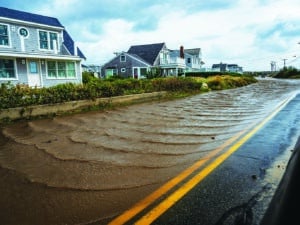
Houses in Falmouth look out on a road being flooded by a “bomb cyclone” storm in 2019. Seaside homes face increasing risks from storm surges and sea level rise as climate change continues.
A new report shows that once-redlined Greater Boston neighborhoods are at a higher risk of flooding and face substantially higher damages if a flood occurs. And because the same neighborhoods still have much higher percentages of minority residents than other areas, the burden of a potential flood may fall hardest on Black, Latino and Asian American Bay Staters than on whites.
The report, from economists at Redfin using data from the First Street Foundation that incorporates climate change-driven increases in flood risk over the next 50 years, shows that 13.8 percent of homes in once-redlined or “yellow-lined” areas in Greater Boston are at a high risk of flooding while only 8.7 percent of homes face that risk in areas that were once “green-lined” or “blue-lined” by the Home Owners Loan Corp. The 5.1 percentage-point gap is the third worst out of the 38 major American metro areas Redfin studied.
The federal Home Owners Loan Corp., or HOLC, fulfilled a similar mortgage-buying function in the 1930s to Fannie Mae and Freddie Mac today and published maps purporting to assess credit risk in urban neighborhoods across America. Neighborhoods – nearly always working-class and dominated by racial minorities or Jews – designated poor credit risks were outlined in red (“hazardous”) or yellow (“declining”), while more middle-class and wealthy areas were assigned blue (“still desirable”) and green (“best”) colors. Over its 20-year existence, HOLC’s maps and policies, which reflected broader trends in the banking sector at the time, helped dramatically increase racial segregation in America.
In Greater Boston, nonwhite households make up 26.8 percent of formerly green-lined and blue-lined areas, while they make up 45.2 percent of formerly redlined and yellow-lined areas, Redfin found, citing Census Bureau data.
“Decades of segregation and economic inequality shoehorned many people of color – especially Black Americans – into living in neighborhoods that are more vulnerable to climate change,” Redfin senior economist Sheharyar Bokhari said in a statement. “Redlining kept home values in Black neighborhoods depressed, which in turn meant there was less money invested and reinvested in those neighborhoods for decades to come.”
So far in Massachusetts, market-watchers say, most prospective homebuyers have not begun to take flood risks into account when deciding how much they would be willing to pay for a home.
However, changes coming to the federal flood insurance program and increasing availability of data on how much climate change could worsen these risks may change that, experts say, with the burden potentially falling harder on once-redlined neighborhoods. Redfin estimates that property worth $3.8 billion is at high risk of flooding in Greater Boston’s once-blue-lined and green-lined areas, while $8.5 billion worth of property is at risk in once-redlined and yellow-lined areas.






